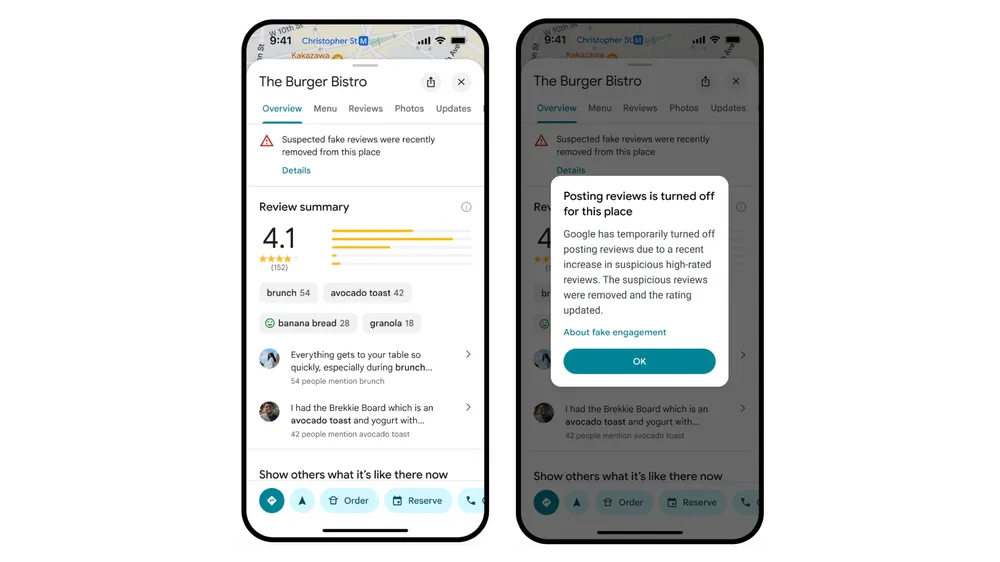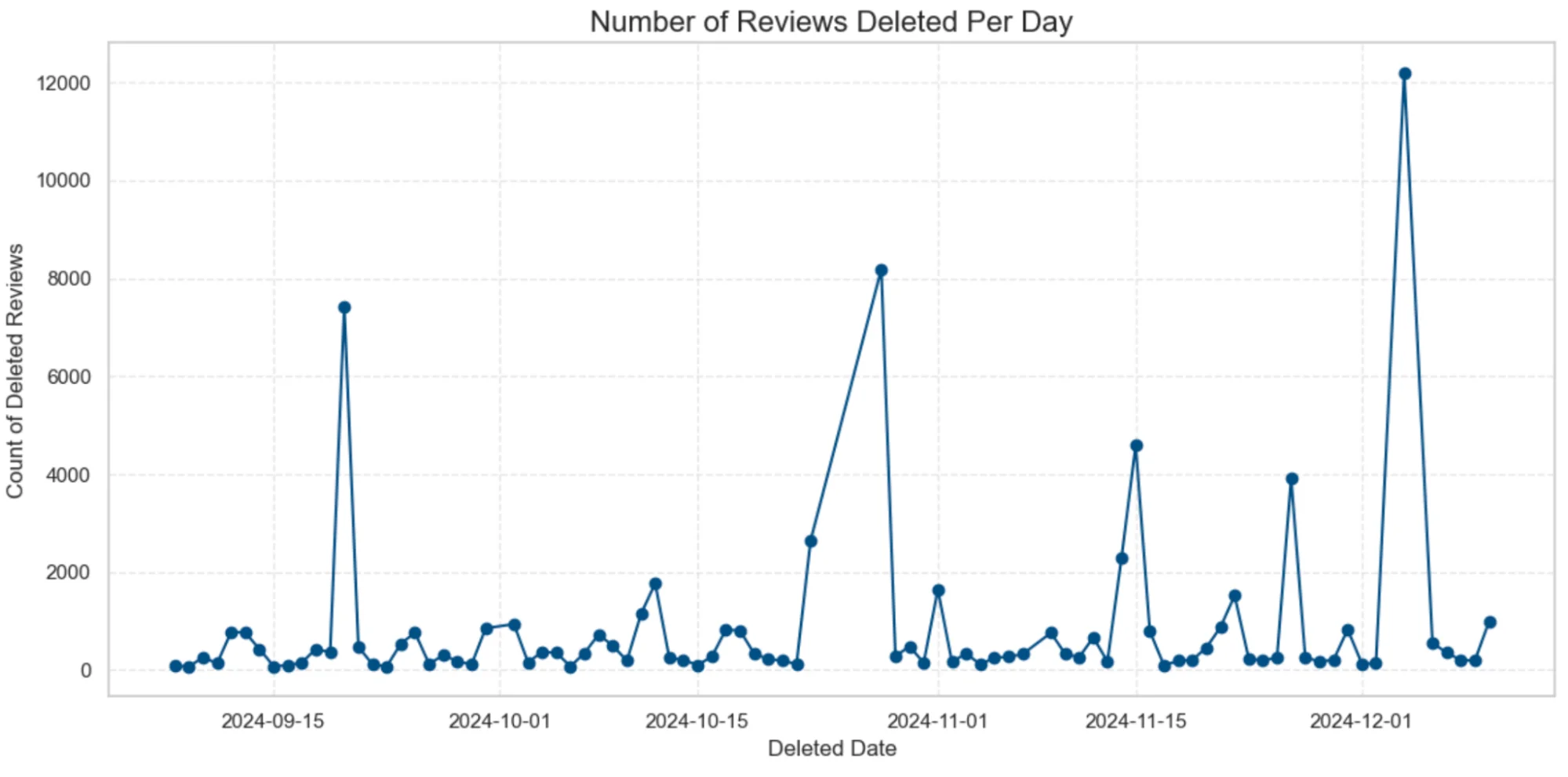How Google Business Profile Reviews Are Filtered for Spam
Have any of your customers told you they submitted reviews on your Google Business Profile (GBP), but you can't see them? There's a possibility that Google filtered out reviews from your profile, believing those reviews were spam. Due to the uptick in fake/spam reviews, Google has been making their review filtering system much stricter over the past few years.
Google's content policies require Google reviews to be based on genuine experiences with the company being reviewed.
When Google detects a review that it deems irrelevant, malicious, or containing a conflict of interest, it will filter the review off your business profile. Naturally, Google employees cannot feasibly moderate the astonishing number of reviews posted every day, and, as a result, they utilize automated systems, including leveraging Gemini, to handle the process.
Table of Contents
- Why Is Filtering Google Reviews a Necessity
- How Does Google Use Automated Spam Detection?
- What Makes a Review on a Google Business Profile Classified as Authentic vs. Spam?
- How to Boost Your Google Business Profile’s Authenticity

Why Is Filtering Google Reviews a Necessity
A review study of 73 million Google reviews and economic analysis of consumer harm was conducted by The Transparency Company with some incredible findings:
- The economic analysis discovered that review fraud is responsible for an estimated $300 billion in annual consumer harm. (This data is limited to only three service sectors: Home Service, Legal, and Medical).
- Ratings and reviews are the single most important influence on consumer purchase behavior; 98% of consumers say they rely on them before buying something.
- The average US household suffers $2,385 in annual economic harm, by being misled by suspicious positive reviews that are likely to be fake.
In 2024 alone, Google's review detection and filtering systems racked up some impressive stats:
- Google published 999,000,000+ total reviews.
- Google's systems blocked or removed more than 240 million policy-violating reviews.
- Google's systems and team placed posting restrictions on more than 900,000 accounts that repeatedly violated Google's policies.
We applaud Google for this progress but also recognize the problem is not solved as a significant number of illegitimate reviews are still being published, and, conversely, some legitimate reviews are being blocked. While we are thankful for the progress, we hope to see continued resources dedicated towards improving review fraud detection systems.
How Does Google Use Automated Spam Detection?
Google's automated systems scan the contents of a review to ascertain whether it or not it contains offensive or irrelevant content. Additionally, if the account posting the review has a history of submitting fraudulent reviews, or your Google Business Profile has suspicious review activity, their review about your business likely won't make it to your profile.
However, on occasion, Google’s spam filter may erroneously detect spam, causing some genuine reviews to get removed. Even after a review is live, Google continually scrutinizes the pattern of reviews on your business profile to rule out any suspicious patterns.
Learn more about how Google Business Profile Reviews works in the video below:
What Makes a Review on a Google Business Profile Classified as Authentic vs. Spam?
Authentic reviews do not contain deceptive content, fake engagement, mature content, spam, profanity, harassment or hate speech, confidential information, or conflicts of interest. While most of the above requirements are straightforward, “conflict of interest” tends to be a bit more confusing. To make this clearer, examples of “conflicts of interest” based on our experience include the following:
- Reviews left by the business owner or employees.
- Reviews left by individuals who are incentivized (either monetary compensation or other incentive) for the review. This directly violates Google’s policies on review collection.
- Reviews by friends, family, or other users that did not use the service or product.
Ultimately, the reviews must be genuine and on-topic since the goal of Google’s policies is to ensure that all reviews are genuine and reliable for searchers. You can read Google’s full Prohibited and Restricted Content Policy online which pertains to reviews and use of other Google tools. Additionally, you can check out our article on who is allowed to write a Google review.
How Does Google Figure Out Which Content is Spam?
The short answer is that it depends. Google’s spam detection system is quite robust, and it is, thankfully, getting better every year. That said, in our experience, their review system does automatic checks on various aspects based on:
- The content of the review
- The reviewer’s credibility and history
- The method in which the review was provided
- The activity of the organization's Google Business Profile
While we do not want to document every detail that we have learned for the sake of not helping spammers thwart the system further, we have included a couple examples of each type below:
- Content of a Review – A straightforward example is if the review content contained a link or a phone number which leads to automatic removal. If the content is suspected to not be relevant to the services you provide, it can be removed. Even content that is simply over-emphasized using phrases that are in all caps, numerous exclamation points, or excessive positive language can even trigger suspicion.
- Reviewer’s Credibility – For example, if the reviewer has gone on a rampage and is leaving numerous hateful reviews on a bunch of businesses with which they have never had legitimate dealings, that account can be flagged, and its reviews removed.
- Method of Review – If Google suspects that the method of collecting reviews is against their policies, they will remove the review. For example, if all reviews come from a single IP address (even if it is your business’ legitimate location), Google may suspect that these are being artificially created or that your incentivizing reviewers to leave a review while they are at your office.
- The activity of the organization's Google Business Profile – Google looks at the Google listing itself to identify if there has been "unusual activity." In its documentation, Google gives an example of unusual activity as an abundance of reviews or edits over a short period of time, or an increase in attention on the listing in local news or social media that would motivate people to attempt to manipulate the listing via reviews.
Google Leverages Gemini for Illegitimate 5-star Review Pattern Detection
On April 7th, 2025, Google released an article stating that it leverages its AI-powered Gemini to detect fake five star reviews. While this article was released in April, we personally believe Gemini has been used for this task much longer. Keep in mind that Google only releases their year in review spam reports annually, so I wouldn't look at the date of the article as a statement of when this feature was rolled out.
We do believe this is a step in the right direction to combat businesses buying fake reviews to manipulate their search engine rankings.
Ongoing Suspicious Review Activity Restrictions
In 2024, Google updated their documentation to state that Google Business Profiles with "fake engagement" can receive penalties that are far worse than certain reviews not being published.
If you're business collects reviews in an illegitimate way or via people who have never had an experience with your company, you should stop. Otherwise, in addition to losing your reviews, Google may do the following:
- Set your Google Business Profile to not be able to receive new reviews or ratings for a set period of time (affectionately known as "review jail" by SEO experts)
- Unpublish your existing reviews or ratings for a set period of time
- Or display a blatant warning on your Google listing that states that fake reviews were removed from your profile.
 This image is courtesy of Google which shows the actual consumer notice that may be displayed.
This image is courtesy of Google which shows the actual consumer notice that may be displayed.
Although this one isn't stated in Google's fake engagement policy or elsewhere, we believe that when Google continues to see illegitimate review activity on your profile, it may influence your profile's overall credibility in Google's eyes and be more likely yield a full suspension, especially if other suspicious activity is also detected on your Google Business Profile.
Reporting a Business That Is Incentivizing or Pressuring Customers for Google Reviews
In 2024, Google launched a public reporting form that allows users to report businesses who are incentivizing/pressuring reviews or buying fake reviews.
Spam Review Filtering System Updates or a Re-assessment Is Triggered
It's also critical to understand that Google continually improves and updates their spam detection system. As such, it's possible for you to have a review, or set of reviews, published for years, then suddenly disappear. We've sadly had this happen on our own profile with legitimate client reviews.
In December 2024, GMBapi.com released a study of over 5 million reviews across 20,000 locations which showed Google ramping up their review deletions on certain days that is likely associated with review filtering system updates.
 Data Courtesy of GMBapi.com
Data Courtesy of GMBapi.com
Reviews that are published for years prior can still be removed in any of the following cases:
- Google's newly updated detection system thinks your review(s) exhibit illegitimate behavior.
- Your review is reported manually by a Google user which triggers Google's systems to reconsider the review's legitimacy.
- The reviewer's Google account gets flagged for suspicion, is disabled, or deleted completely.
As such, it's wise to keep an eye on your review collection process and total number of reviews in case a selection of reviews disappears due to an update. You can monitor your review count using a reputation management system like Whitespark's Reputation Builder or BrightLocal's Reputation Manager. Both of which can help you automate the review collection process, as well as monitor the total number of reviews you have on your profile.
How Do I Know If My Company’s Reviews are Flagged as Spam or Hidden?
First, was the review legitimate? If not, move on and choose to adopt legitimate review collection practices that abide by Google’s policies.
Even if your review was legitimate, unfortunately, Google does not send you a notification if a review is filtered out during publishing or removed at a later time. However, if a customer notifies you that they left a review, but you cannot see it online, do not assume the customer did something wrong. Wait a few days to see if the review appears.
If the review still does not appear after the wait period, it may have been filtered out by Google’s review spam detection system.
What Can I Do if Legitimate Reviews are Being Marked as Spam?
You can reach out to Google Business Profile support, but they will often state that review removals are final and that nothing can be done at this point. While that is the default canned response, we have found this to be slightly less than true.
Interestingly, even if the review is filtered out, the reviewer can usually see the review they posted on your Google Business Profile via the account from which the review was created. If you can get the customer to capture a screenshot of the review (including their public name on the review) and send it to you, this can be greatly helpful in troubleshooting.
If the customer legitimately did something wrong within their review (e.g. included a link, wrote seemingly spammy content, included confidential information, etc.), you can ask them to edit their review and repost it. This may cause the review to be re-evaluated and get published after a few days.
If the review looks legitimate and you cannot determine why it is being filtered out, you can use Google's Help form. Via the form, complete the following steps:
- Ensure you're logged into a Google account which has access to the business profile you are troubleshooting.
- Select your business in the dropdown (if you're a multi-location business, be sure to select the correct location).
- Under the "tell us what we can help with field," enter "missing review" and select next.
- Under the best description of this issue section, select "review missing."
- Select Next Step (you may have to do this twice to get passed default help articles).
- Under contact options, click "Email" which will trigger the missing review form fields.
- Fill in all required fields and as many optional fields as possible. The more thorough your response, the higher your chance that the review will be reinstated.
- If you are a marketing/SEO agency, selecting the "I own/work for an agency..." option will allow you to upload the image of the review which helps expedite the process.
- Submit the form and record the Case ID for future reference.
What If the Google Support Form Does Not Help?
If after 2 weeks, you have not heard back from Google support, create a post on the Google Business Profile Help Forum. This forum is moderated by third-party product experts. If you have a legitimate case with solid proof, they may be able to escalate your case to Google support for resolution. It is best if you can include the following in your forum post:
- The case ID provided by submitting the form
- Your Business name and associated Google Maps URL
- Image of the review(s) if possible which you can gather from the review. This part is of course not always possible, but it drastically helps your chances of the review being reinstated.
Using this method, we have personally seen legitimate reviews reinstated successfully on numerous occasions.
How to Boost Your Google Business Profile’s Authenticity
Apart from knowing how to adhere to Google’s guidelines, it is also essential to understand and accept that there will be both positive and negative reviews for your business. Google anticipates a mix of reviews on profiles.
However, the authenticity of your Google Business Profile does not stop there. At Igniting Business, we recommend our clients focus on improving the overall Google Business Profile health which includes reviews as one crucial element. Some review collection and SEO tools, like Whitespark and BrightLocal, make it easy to request, monitor, and respond to genuine reviews – both the good and bad.
Alternatively, working with a quality reputation management service helps to monitor all the conversations about your business and address the negative reviews that might hurt your brand and its online reputation. If you are interested in implementing reputation management for your small business, contact our team of SEO experts today.
At no additional cost to you, we may receive a commission if you click on some of the links on this website and make a purchase.
About the author
Ben Seidel is the CEO and Founder of Igniting Business. Ben has been serving hundreds of small businesses with web design and SEO services for over 15 years and covering digital marketing related topics since 2012.
Over the years, Ben has been recognized on a local and national level, including entrepreneurship awards from both the NFIB and NASE and being featured in publications such as CNBC Universal, Yahoo News, Intuit Small Business, CIO.com, Mizzou Magazine, and Fox Business.